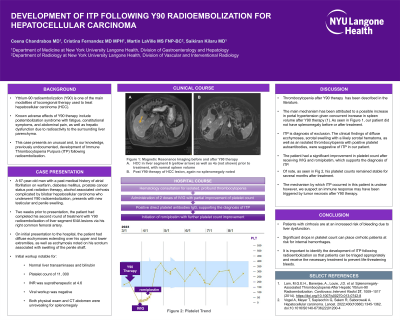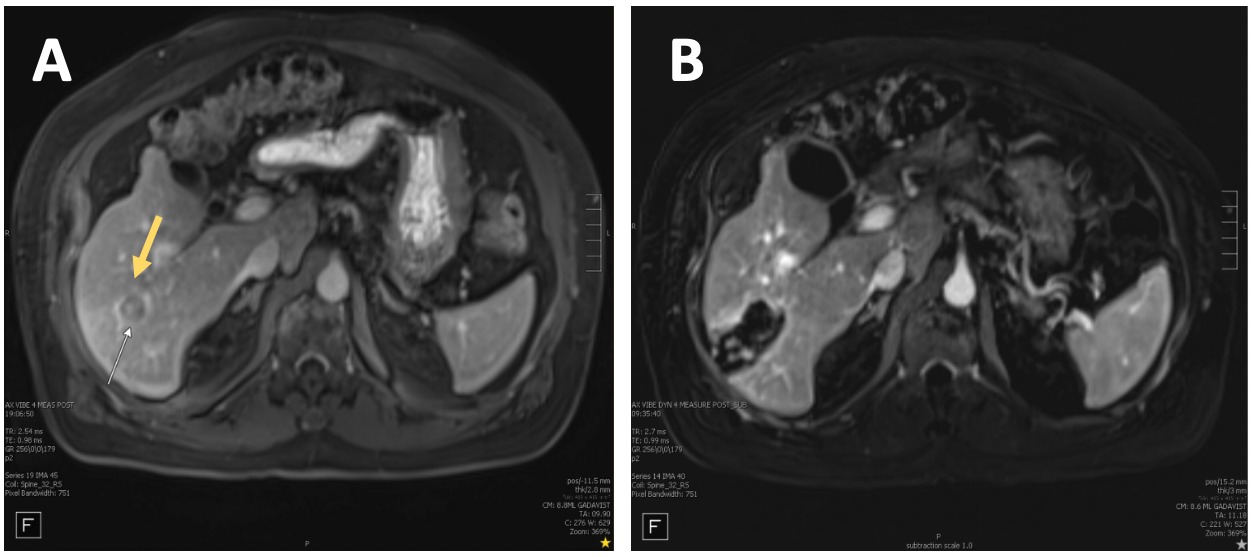Monday Poster Session
Category: Liver
P2521 - Development of ITP Following Y90 Radioembolization for Hepatocellular Carcinoma
Monday, October 23, 2023
10:30 AM - 4:15 PM PT
Location: Exhibit Hall

Has Audio
- CC
Ceena Chandrabos, MD
NYU Langone Health
New York, NY
Presenting Author(s)
Ceena Chandrabos, MD, Cristina Fernandez, MD, MPH, Martin J. LaVille, MS, RN, FNP-BC, Saikiran Kilaru, MD
NYU Langone Health, New York, NY
Introduction: Yttrium-90 radioembolization (Y90) is a commonly utilized treatment for hepatocellular carcinoma (HCC). Post-Y90 thrombocytopenia has been previously described in association with the development of splenomegaly after Y90, presumably due to splenic sequestration. We present an unusual development of thrombocytopenia due to immune thrombocytopenia purpura (ITP) following radioembolization, which illustrates the importance of vigilance for atypical complications after hepatic locoregional therapy.
Case Description/Methods: A 67-year-old gentleman with past medical history of atrial fibrillation on warfarin, prostate cancer status post radiation therapy, and alcohol related cirrhosis complicated by bilobar HCC, presented to the hospital with groin swelling 2 weeks after Y90 treatment. Two weeks prior to presentation, he completed his second Y90 radioembolization via right common femoral artery access. On presentation, he had diffuse ecchymoses, including scrotal ecchymosis associated with scrotal and penile swelling. Physical exam and CT abdomen did not reveal splenomegaly or any hematomas. Initial labs were notable for a WBC of 4K, Hgb 10 g/dL, platelets of 11K, and normal liver enzymes. His baseline platelet count prior to procedure was approximately 200K. Coagulation panel was notable for INR 4.6, aPTT 49, and fibrinogen 168. Viral workup and hepatitis serologies were negative. Peripheral blood smear showed occasional schistocytes and no giant platelets. The leading differential of ITP was confirmed with positive anti-platelet antibodies (IgG). He was treated with IVIG and romiplostim with improvement in his platelets to 81K on discharge. Following 1 week of romiplostim, his platelets improved to 322K and his ecchymoses also resolved. He is currently in evaluation for liver transplant given his diagnosis of bilobar HCC.
Discussion: Development of ITP following Y90 treatment has not previously been described, though post-Y90 thrombocytopenia associated with splenomegaly has been previously described in the literature. Another potential etiology of post-Y90 thrombocytopenia is myelotoxicity related to radiation. ITP is a diagnosis of exclusion, but can be supported by the presence of anti-platelet autoantibodies and response to IVIG and romiplostim. Prior studies have revealed systemic immune activation after Y90, which may explain precipitation of ITP, but further research is warranted.

Disclosures:
Ceena Chandrabos, MD, Cristina Fernandez, MD, MPH, Martin J. LaVille, MS, RN, FNP-BC, Saikiran Kilaru, MD. P2521 - Development of ITP Following Y90 Radioembolization for Hepatocellular Carcinoma, ACG 2023 Annual Scientific Meeting Abstracts. Vancouver, BC, Canada: American College of Gastroenterology.
NYU Langone Health, New York, NY
Introduction: Yttrium-90 radioembolization (Y90) is a commonly utilized treatment for hepatocellular carcinoma (HCC). Post-Y90 thrombocytopenia has been previously described in association with the development of splenomegaly after Y90, presumably due to splenic sequestration. We present an unusual development of thrombocytopenia due to immune thrombocytopenia purpura (ITP) following radioembolization, which illustrates the importance of vigilance for atypical complications after hepatic locoregional therapy.
Case Description/Methods: A 67-year-old gentleman with past medical history of atrial fibrillation on warfarin, prostate cancer status post radiation therapy, and alcohol related cirrhosis complicated by bilobar HCC, presented to the hospital with groin swelling 2 weeks after Y90 treatment. Two weeks prior to presentation, he completed his second Y90 radioembolization via right common femoral artery access. On presentation, he had diffuse ecchymoses, including scrotal ecchymosis associated with scrotal and penile swelling. Physical exam and CT abdomen did not reveal splenomegaly or any hematomas. Initial labs were notable for a WBC of 4K, Hgb 10 g/dL, platelets of 11K, and normal liver enzymes. His baseline platelet count prior to procedure was approximately 200K. Coagulation panel was notable for INR 4.6, aPTT 49, and fibrinogen 168. Viral workup and hepatitis serologies were negative. Peripheral blood smear showed occasional schistocytes and no giant platelets. The leading differential of ITP was confirmed with positive anti-platelet antibodies (IgG). He was treated with IVIG and romiplostim with improvement in his platelets to 81K on discharge. Following 1 week of romiplostim, his platelets improved to 322K and his ecchymoses also resolved. He is currently in evaluation for liver transplant given his diagnosis of bilobar HCC.
Discussion: Development of ITP following Y90 treatment has not previously been described, though post-Y90 thrombocytopenia associated with splenomegaly has been previously described in the literature. Another potential etiology of post-Y90 thrombocytopenia is myelotoxicity related to radiation. ITP is a diagnosis of exclusion, but can be supported by the presence of anti-platelet autoantibodies and response to IVIG and romiplostim. Prior studies have revealed systemic immune activation after Y90, which may explain precipitation of ITP, but further research is warranted.

Figure: A. HCC in liver segment 6 (yellow arrow) as well as 4a (not shown) prior to treatment, with normal spleen volume
B: Post Y90 therapy of HCC lesion, again no splenomegaly noted
B: Post Y90 therapy of HCC lesion, again no splenomegaly noted
Disclosures:
Ceena Chandrabos indicated no relevant financial relationships.
Cristina Fernandez indicated no relevant financial relationships.
Martin LaVille indicated no relevant financial relationships.
Saikiran Kilaru indicated no relevant financial relationships.
Ceena Chandrabos, MD, Cristina Fernandez, MD, MPH, Martin J. LaVille, MS, RN, FNP-BC, Saikiran Kilaru, MD. P2521 - Development of ITP Following Y90 Radioembolization for Hepatocellular Carcinoma, ACG 2023 Annual Scientific Meeting Abstracts. Vancouver, BC, Canada: American College of Gastroenterology.
